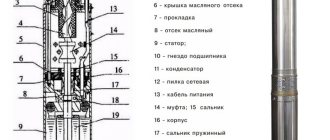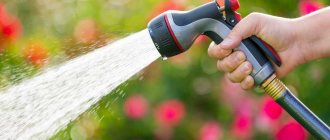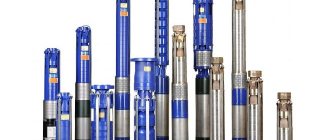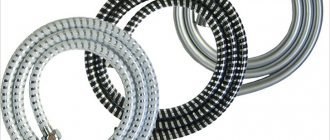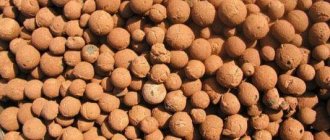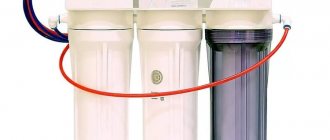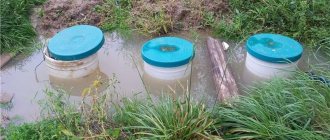A hose for the pump can be purchased at a hardware store or a specialty store. You should think about purchasing a hose before or immediately after installing a water pump. There is a wide range of them, but how to choose a good reinforced one for drainage? The manufacturer, the material from which the pump hose is made, the purpose, the diameter - all this is important when purchasing, since only a high-quality and correctly selected part will last a long time, will not become cracked and will not leak water.
How to choose the “right” hose
This matter is not as simple as it might seem at first glance. Pay attention at least to the range of these products in the store.
You can get confused when you discover that they are made of different materials, and they differ from each other in design, flexibility, strength and other characteristics. So which hose is best for a well?
Determining the requirements
We will select the product we need using the method of elimination. First of all, we exclude hoses intended exclusively for watering.
They can be connected to the well at the outlet, but only for use in the warm season:
- For collecting water in various containers;
- For washing cars and paths;
- For watering;
- To organize summer water supply to the house.
We need a hose with certain characteristics that is sufficiently rigid and can withstand heavy loads. Such products are called intake hoses and are intended for use inside a well.
What parameters you need to pay attention to:
- Degree of hardness . The hose for drawing water from the well should not shrink or collapse when the pressure in it changes. This is a must. Rigidity is imparted in various ways - corrugation, reinforcement, increasing wall thickness, etc. That is, we can already exclude products that do not meet these requirements.
Corrugated hose
Advice. The most reliable in this regard are hoses reinforced with a steel spiral. They can withstand severe pressure changes and have a long service life.
- The next criterion is frost resistance . It is only important if you plan to use the well all year round. The hose should not change shape (flatten) and lose strength characteristics at low temperatures.
- Finally, if the water from the well is intended for drinking and cooking, the instructions require the use only of products made from so-called food materials. Water passing through rubber hoses will have an unpleasant chemical odor, and over time the rubber will begin to break down and release harmful substances into the water.
Black reinforced rubber hose can be used in wells intended only for irrigation and technical needs
Choose from the remaining assortment
If we are talking about a drinking well, then after all our manipulations with screening, from the entire assortment there will only be two options suitable for this purpose - a special polyvinyl chloride hose for a well pump and a silicone sleeve.
So:
- Silicone hose, like any other products made from this material, is suitable for food use. It is odorless and very durable. But such a hose still does not have sufficient strength and rigidity and can burst in the most vulnerable places - at connections with adapters, fittings, and a well pump. Therefore, it is recommended to use it only for installing summer water supply.
- PVC hose has the best characteristics. It can also be used to supply drinking water, and at the same time it tolerates frost well, does not collapse when the pressure decreases, and is characterized by high strength characteristics and good elasticity. At the same time, its price is very affordable.
The photo shows a three-layer reinforced intake hose
Other product categories
Today, 2 types of hoses for drainage systems are being developed:
- Fence.
- Watering.
Suction hoses are characterized by the following control parameters:
- Products are reinforced to increase strength characteristics;
- Manufactured with the addition of metal or hard PVC;
- They are developed in various configurations with the addition of water filtration devices or check valves;
- Withstand pressure up to 6 bar;
- They work with liquid temperatures from -10 to 50 degrees.
Reinforced hoses are made using a special polyester thread. This material helps to increase the wear resistance of hoses for drainage fecal pumps and increases the possible service life of the product. Products made using polyester make it possible to withstand fairly high pressure.
Corrugated hoses are considered a type of reinforced hoses, but they are made using spiral technology. Such elements are divided into segments. There are light, medium and heavy corrugated hoses. The medium shape is strong enough to be used on drainage pumps for suctioning household waste.
After installing the water pump, you should think about purchasing a hose. Now there is a huge assortment of such parts, but in order to choose a good hose, it is better to become familiar with the manufacturer, the material from which it is made, and the diameter.
These characteristics can protect the part from mechanical stress and low temperatures during the cold season, because the main problems with additional parts for pumps are cracks and water leakage.
General information
It should be said right away that there are two types of hoses:
- Watering;
- Fence.
For a well, it is necessary to use products of the second type. They are made with a certain requirement for the level of rigidity, since the product is subjected to quite large loads .
Their manufacturing technology involves reinforcement, which prevents compression of the hose. A similar situation can arise as a result of a decrease in pressure. In addition, reinforced hoses are more durable because they do not tear, unlike rubber and corrugated products.
Sleeve reinforced with steel spiral
,
Installation of a condensate drainage system
This process is very simple.
It is necessary to remove the lower fasteners from the air conditioner body so that it can rise. In the lower part, under the fan that blows the evaporator, there is a tray for collecting condensate. There is a pipe on its side, and it is to it that you need to attach the drainage pipe for removing condensate from the air conditioner using a clamp. The indoor unit housing is lowered and installed in place
In this case, it is very important that the corrugation passes through it through a special hole made in the side wall. The fasteners are screwed into place. Now all that remains is to take the attached corrugated hose either into the sewer or onto the street
If the withdrawal process is associated with the installation of a drainage route, then you must first decide how easier and more convenient it is to carry out the entire process. As mentioned above, the best option is to make grooves into which to lay the hose. The most important thing is to maintain an inclination angle of at least 3%.
Now all that remains is to remove the attached corrugated hose either to the sewer or to the street. If the withdrawal process is associated with the installation of a drainage route, then you must first decide how easier and more convenient it is to carry out the entire process. As mentioned above, the best option is to make grooves into which to lay the hose. The most important thing is to maintain an inclination angle of at least 3%.
Basic drainage problems
The most common malfunction of the condensate drainage system from the air conditioner is a clogged hole in the bath. Dust and dirt with condensation settle to the bottom of the pan, where sludge forms. It grows and covers the pipe. The consequence is the flow of water over the edges of the bath. The liquid begins to drip onto the floor and leak down the walls.
And other malfunctions:
- If the air conditioner works for heating in winter, then often the drainage pipe on the street simply freezes.
- The slope of the drainage route was set incorrectly.
- If the pump fails.
- If the amount of refrigerant in the system has decreased, which leads to icing of the evaporator and supply pipes, so the ice begins to melt along the entire length of the route, pouring water onto the floor.
- The evaporator may become covered with ice if the pressure regulator stops working. If the temperature outside the window begins to decrease, this can lead to a decrease in the freon temperature due to a drop in its pressure.
Cleaning the drainage system
You can clean the condensate drainage system from the air conditioner with your own hands only if the bathtub pipe is clogged. To do this you need:
Remove the filters located on the device body in front of the evaporator. They must be washed thoroughly. The air conditioner housing is raised. The drainage tube is disconnected from the pan. The latter is removed and washed
Pay special attention to the hole. If the tube is clogged in the same way as the drain hole, then it must be blown out. If that doesn't work, you'll have to replace it with a new one. All other steps for assembling the condensate drain system are performed in the reverse order.
Experts recommend using a chlorhexidine solution to disinfect drains and the condensate drain pan. Although any household detergent that contains chlorine will easily cope with the task.
For other malfunctions associated with the failure of one or another device or part, it is better to call a specialist. Independent actions can lead to irreparable consequences.
https://youtube.com/watch?v=L-4-BgJKNoo
Intake hoses in Moscow
Intake hoses and other products can be purchased at Leroy Merlin in Moscow at low prices. Select the product you are interested in on the website and buy it in our online store. The range of products presented in the catalog is extremely wide. Among them there will certainly be a position suitable in all respects.
All products presented in the “Intake Hoses” section are produced by well-known companies that have proven themselves to be of high quality for their products.
You can always place an order and pay for it online on the official website of Leroy Merlin in Russia. For residents of the Moscow region, we not only have low prices for goods in the “Fence Hoses” category, but also fast delivery to cities such as Moscow, Balashikha, Podolsk, Khimki, Korolev, Mytishchi, Lyubertsy, Krasnogorsk, Elektrostal, Kolomna, Odintsovo, Domodedovo , Serpukhov, Shchelkovo, Orekhovo-Zuevo, Ramenskoye, Dolgoprudny, Pushkino, Reutov, Sergiev Posad, Voskresensk, Lobnya, Ivanteevka, Dubna, Yegoryevsk, Chekhov, Dmitrov, Vidnoye, Stupino, Pavlovsky Posad, Naro-Fominsk, Fryazino, Lytkarino, Dzerzhinsky , Solnechnogorsk, Istra and Zhukovsky.
Inlet pipe diameters
The choice of pump inlet diameter depends on the environment in which it will operate. For clean water, a diameter of 0.5 - 1.5 inches is sufficient, for dirty liquid with mechanical inclusions - at least 8 inches.
Pay attention to the location of the outlet pipe: horizontal or vertical. Choose the one that suits your case
The price of a drainage pump for sewerage in a private house depends on the chosen model and its design. Typically, buyers choose universal models that can pump both clean water and water with sand and silt. The best choice for a private home would be a submersible pump with water intake in the upper part of average power. It is small in size, does not require frequent maintenance, is easy to install and has a long working life.
Advantages of PVC hose:
- The strength of the material, nothing will happen to the hose, it is resistant to mechanical damage;
- The product is not afraid of exposure to ultraviolet radiation, it is not afraid of aggressive environments;
- Has light weight;
- Low price for Moscow;
- Any product diameter;
- The streamlined inner walls do not retain the pumped contents;
- Suitable for pumping any water (drinking, irrigation, etc.);
- The rigid design protects against twisting and creasing.
The PVC pressure and suction hose for water has good characteristics and low cost, which is why it has become popular in Moscow. The spiral reinforcement prevents it from twisting, which makes it much easier to use.
The hoses presented in the SantechClass online store are made in Russia and are designed for operating temperatures up to 60 degrees. These are strong, durable and reliable products with a plastic-silicone base. You can buy a water suction hose from us at an affordable price. We offer a delivery service in Moscow and other cities.
A private house on a site that is not equipped with a centralized sewerage system causes a lot of hassle in disposing of wastewater. It is not enough to dig a sewer well; you also need to choose the right equipment that will help clear it of waste. Such equipment can be a properly selected and installed drainage pump model. And in order to provide for all the nuances of proper installation, you need to clearly determine the required parameters of the inlet and outlet pipes of the device and select the appropriate hose for the drainage pump. Then your system will perform the required functions smoothly and efficiently.
To choose the right pump, you need to decide what types of wastewater you need to remove from your site. If it is heavily polluted, viscous sewage, a fecal pump will help. If you need to drain water with technical inclusions in the form of sand, gravel, limestone or slightly polluted wastewater, choose drainage pumps.
All types of pumps are divided into submersible and surface pumps.
Submersible pumps operate with a casing immersed in liquid. The pump body and blade mechanism are made of high-strength materials that are resistant to corrosion and can withstand heavy loads and a large volume of abrasive particles. The submersible pump can operate at low temperatures, as well as in any weather. The inlets are located directly on the body of the device and can be top, bottom or side.
There is a reason for this difference in the location of water intake holes - for work in natural reservoirs, the top or side inlet is usually chosen. The lower one works well in flooded areas where maximum dehumidification is required. Since the pump is immersed in water, it does not need to fit a hose to the inlet. The diameter of the outlet hose depends on the productivity and power of the device - the further the water is discharged, the larger the diameter should be.
Surface pumps can be installed directly next to the source from which water needs to be removed. The operation of the device is limited to a well depth of up to 5 meters, as well as adverse weather conditions. The advantage of the surface apparatus is that it is easy to carry and install. Therefore, it is preferable in areas where there are several sources of drainage water or sewage pits. For such a pump, you need to select a reliable hose that will be connected to the water intake, as well as another through which wastewater will be discharged. The diameter directly depends on the power and performance of the pump.
Why is it better than a pipe?
The drain pump hose remains flexible at all times, regardless of whether it is empty or filled with water. This quality distinguishes it favorably against the background of a stationary pipe. The same pump can be used in different areas. When buying a drainer, you cannot think that it will serve in the same place for its entire service life. Suddenly you need to move equipment. This cannot be done with a rigid outlet pipe.
During operation, drainers create a discharged environment in the pipe. A flexible rubber and silicone hose will help soften the pressure and prevent the liquid from splashing out jerkily. In addition, the water hammer in the pipe is much stronger.
Hose selection
The basic requirements for the product, in addition to reinforcement, are as follows:
- In cold weather, the hose tends to flatten, after which the water in it immediately freezes. Therefore, it is advisable to use a three-layer product and be sure to insulate it. We will look at how to do this below.
- When choosing a product, you should pay attention to the possibility of its use for food purposes. Ordinary black rubber hoses cannot be used to collect drinking water, as it will have a characteristic chemical smell.
- The product must be frost-resistant.
As a result of these requirements, a number of products should be immediately discarded.
In fact, there are two more or less suitable options left:
- Silicone sleeve;
- PVC borehole pump hose.
Now let's take a closer look at both of these options.
Rubber hose is not suitable for drinking water
Silicone
Silicone hose is an excellent option for food grade use. As a rule, there is a special food coating inside it. It is pleasant to drink water from such a water supply, since it does not smell of anything.
However, this product has some disadvantages:
- Silicone often cracks and breaks where it connects to the pump and fittings.
- The rigidity of the product is rather weak.
For these reasons, silicone water pipes are used only in the summer.
Silicone hoses
PVC
For all-season use, the best option is a three-layer PVC hose:
- It doesn't "collapse";
- Frost-resistant;
- Moderately elastic;
- Can be used for food purposes;
- Has sufficient strength;
- Affordable price.
Thus, when choosing which hose is best for a well, it is quite possible to opt for a plastic product.
In the photo - a PVC sleeve
Advice! You should purchase the product in branded stores so as not to buy a low-quality product that does not meet the necessary standards.
Kinds
- Fecal apparatus. Pumping out cesspools and sewers is complicated by the presence of thick particles and small debris in the water. Only a powerful pump with a corrugated reinforced hose for releasing sewage can cope with this task. The diameter of the outlet must correspond to the vent on the unit.
- Submersible devices. There is no debris in the water where the device operates, or it is so small that the impeller can grind it. For normal operation of the submersible pump, a reinforced rubber or PVC hose is suitable. Silicone is not quite the right choice. Its ability to stretch can lead to cracks.
- Surface devices, in addition to the discharge pipe, also have a retractor. They must be the same diameter and cross-section. The material used is durable and non-deformable. A rubber product reinforced with thread will do.
- Deep devices are very powerful. An ordinary PVC or silicone hose is not enough to deliver water to the surface. Choosing the wrong section may cause the end attached to the device to become detached at depth. Excessive pressure generated by the pump will knock out a hose that is too narrow. At the same time, the thick one will not have time to fill and raise water to the surface.
- Peristaltic pumps. The principle of operation is to narrow the rubber tube inside the housing by rotating the shaft in one direction. To discharge water from such equipment, only silicone and PVC products are applicable.
General characteristics of the hose
The main characteristic is thickness, namely:
- Internal.
- External.
- Walls.
There are standard, economical and vacuum. The average internal thickness of vacuum devices is 32 mm, the largest is 50 mm, the wall thickness is 5-6 mm, and the outer diameter is 30-62 millimeters (two wall thicknesses plus the internal diameter). For example, equipment with an internal diameter of 32 millimeters and a wall of 5 mm will have an outer diameter of 42 mm. The maximum thickness of standard and economical is 1 inch (25 mm). Inch is suitable for most purposes. There are samples with a wall less than 1 mm.
Reinforced intake hoses
During installation, the outer diameter is taken into account; it determines the size and number of fasteners. Strength and flexibility are affected by wall thickness. The internal diameter is responsible for the possible pressure, pressure and conductivity of the liquid.
Trusted brands
Drainage pumps with good reliability can be found among examples of varying prices. Let's consider popular options.
Italian brand Pedrollo
One of the main manufacturers of pumping equipment. These are drainage pumps for dirty water with an open rotating element of the centrifugal type. The block and other components are made of plastic using fiberglass, resulting in increased resistance to possible damage.
As an example, we can consider the Pedrollo TOP Vortex device, which has its own characteristics:
- all main elements are made of good quality plastic;
- it is capable of pumping dangerous components;
- It is possible to pump liquid with additives up to 20 mm.
This device is designed for long-term operation, can be used during partial immersion, and has an emergency shutdown device. It is powerful and easy to use. Can be used in a sprinkler system.
Russian pumps Gilex
This brand appeared on the market in the 1990s and quickly earned the attention of its fans. After all, these devices are distinguished by their unpretentiousness and are able to operate during voltage surges.
They are inexpensive, yet they are a quality product.
In our country there are many service workshops capable of performing high-quality maintenance or repair of equipment. These are submersible pumps for dirty water, pumping liquid with additives measuring 5-40 mm. They have a long service life.
For example, you can take Drainage 200/10f, which has its own uniqueness:
- submersibility up to 8 m;
- 880 W electric motor;
- A float is provided to create an autonomous operating mode.
Works in ponds, well shafts, sewer tanks.
German quality from Karcher
The brand produces a high quality product and has a good throughput capacity of up to 18,000 l/h.
As an example it is worth citing:
- Drainage pumps for dirty water Dirt are capable of transporting liquid substances with components up to 30 mm in size. They are successfully used in flooded buildings.
- Flat models are used to transport a cleaner environment and are installed in drainage wells and storage tanks. Capable of pumping water to a minimum depth of 1 mm. Such designs use intelligent sensors that instantly respond to sudden changes in the environment.
- The SDP 9500 models are distinguished by their power and ability to transport working media with solid elements up to 20 mm in size. There is a switch in the form of a float mechanism and a special gasket that increases operating time.
Gnome brand dirty water pumps
The brand has options for different purposes. They differ:
- housings with increased tightness;
- capable of pumping liquid media with a density of 1100 kg/m³;
- possible size of hard additives up to 5 mm;
- can transport substances heated to 35-60 °C.
One of the interesting specimens is Gnome 10-10. It has a 1.1 kW electric motor, is capable of delivering a pressure of up to 12 m and transporting liquid over a distance of 18 meters. Such a device is well used for irrigating a home garden and can be used for a long time.
Inexpensive drainage pumps from Prorab
This brand appeared not so long ago, but already has many fans. The price-quality ratio of the product is excellent here.
For example, you can consider the PRORAB 8720 PP submersible pump for dirty water, which differs:
- excellent performance characteristics and low cost;
- can transport contaminated liquid media with solid fractions up to 35 mm in size;
- has a switching device in the form of a float;
- immersion depth up to 5 m;
- The throughput of the device is 12,000 liters/hour.
It is economical and small in size. Used in a well shaft.
What types of pumps are there?
First, let's look at the types of pumping units and their purpose.
- submersible pumps are units that are designed to pump water when immersed below the liquid level
- borehole pumps are also submersible in nature, the difference is that these are deep-seated devices capable of operating at great depths
- drainage pumps – used to pump out accumulated liquids (swimming pools, basements, flooded areas, etc.)
- fecal pumps - as the name suggests, help clean septic tanks and cesspools by pumping out (in some cases, pre-grinding) fecal matter
- surface pumps and stations are designed to stabilize and increase water pressure in water supply systems, watering plants and pumping clean water
Insulation of wells and pipelines, backfilling
Now that the pipeline through the site has been completed and the end of the pipe is lowered to the water in the well, you can move on to insulation measures.
First, from the lower frost line to the main surface of the soil, insulating material is fixed or sprayed around the walls of the well - this can be polystyrene foam, polyurethane foam (spraying), polyethylene foam. Less often - mineral wool, since it is not all good with moisture resistance. You will also have to provide waterproofing separately for the insulation, and this is unnecessary trouble and expense.
Insulation of the well to the level of soil freezing.
- Instead of mineral wool, polyurethane foam can be used, which is sprayed onto the surface. As a rule, a specialist with special equipment is invited to carry out this process, but you can insulate the surface yourself using polyurethane foam, which is applied to the moistened walls. Moisture will increase the adhesive properties of the materials, and the foam will adhere well to the concrete.
- Foamed polyethylene is the most affordable material both in price and installation. It has excellent flexibility, so it is easy to wrap around the well. The material can be secured using moisture-resistant plumbing tape. Additionally, the canvas can be secured with wire. For insulation you will need polyethylene having a thickness of 10 mm, which is mounted in two layers.
Insulating a water pipe in a ditch using an expanded polystyrene panel.
- In cold regions, it is advisable to provide additional insulation by laying a layer of insulating material on top of the pipeline - this can be a 100 mm thick expanded polystyrene panel. The material is inexpensive, and this measure will protect the water supply in case of any abnormal frosts.
- After insulation is completed, backfilling of the previously selected soil around the well and ditch continues. For backfilling, a sand-gravel mixture is also widely used, which is recommended to be used to fill the trench before laying the soil there.
The backfill will inevitably shrink over time, so do not rush into concreting the blind areas - it is better to do this in a few months.
Options for arranging a clay “castle” around a well.
- One of the effective ways to additionally waterproof the outer walls of a well is to create a clay “castle”, which can protect the area around the walls of the shaft from the effects of precipitation.
The clay seal is installed at the stage of filling the sand-gravel mixture and soil into the space around the well after it has been waterproofed and insulated. The recommended dimensions of this compacted clay layer are clearly shown in the diagram above.
Laying a clay castle around the well.
In this case, concrete blind areas are built on top of a clay castle.
Tips for installation and operation
First of all, I would like to warn you that you should purchase any equipment and related materials for a well not in the markets, but in specialized stores. Even better - branded ones.
Otherwise, you risk purchasing a counterfeit or a product whose actual characteristics do not correspond to those declared.
This applies not only to pumps and hoses, but also to all kinds of fittings and fasteners. Otherwise, after some time you will have to decide how to get a hose out of the well that has fallen down due to corrosion of the clamp.
Advice. By the way, if this happens, we recommend using the “cat”. This is a special heavy metal hook attached to a long pole or tied to a strong rope.
Often, the intake hose is also used to supply water to the house, that is, from outside the well. If it is laid in the ground below the freezing level of the soil, no additional steps to insulate it are necessary.
The surface supply is not insulated either. But in order for the hose not to freeze in winter, it must remain empty between water injections and there should be no air movement in it.
What do I need to do:
- Lay the hose from the exit from the well to the entry into the house with a uniform slope of 3-5%, avoiding kinks and sagging - it is in such areas that water can accumulate.
- In order for the hose to lie flat and be securely fixed in a given position, it is enclosed in a wooden box or plastic pipe knocked together with your own hands, under which supports are placed to ensure the desired slope.
Winter water supply scheme
- To prevent warm air from the well from “walking” in an empty hose, forming frost inside it, it is necessary to equip a water seal. It is done simply: inside the room, the hose is laid with a deflection (sag), into which water will flow after turning off. It will serve as a barrier to air flow.
Insulation of water supply
In order for the well to be used in winter, it is necessary to prevent the hose from freezing. This is not insulation, in the literal sense of the word, it’s just that the water supply system, after supplying water from the well, remains empty, so there is nothing to freeze over.
This method is the most effective, and practically does not require additional costs. You just need to properly organize with your own hands the supply of water from the pump to the point beyond which the aquifer system will be at above-zero temperatures.
The instructions are quite simple:
- A box with an opening lid is made from an inch board.
- One end of the box is installed on the well, and the other is brought to the base of the house, and the box must be located at an inclination of at least 5 degrees with a decrease towards the well.
- The box is necessary so that the water supply system lies on a slope and in no case bends. Otherwise, the water will freeze exactly at the point of deflection. In addition, the box cover protects the well from foreign objects getting into it.
- The well should be cut below ground level, and the water supply should be routed through a duct under the house, so that nothing in the yard will be disturbed.
- The water supply along the entire path, to the line where it intersects with the floor, should have approximately the same slope.
- After this, one simple but very important element is performed - a water seal in the hose, inside a warm room. The area with the deflection should be about a meter, after which the water supply is directed into the container to be filled. It is this seal that will prevent the aquifer system from freezing in any frost.
Water supply insulation scheme
As a result, the aquifer system remains empty from injection to injection, while the shutter does not allow the movement of relatively warm air from the well. In addition, the water seal has another advantage - when the pump is turned on, characteristic gurgling sounds appear, which indicate that the system is working properly.
This type of “insulation” has been tested over years of using the aquifer system in permafrost conditions. Therefore, you can safely use the recommendations without fear of being left without water in severe frosts.
Advice! During various installation works, the hose is often dropped into the well, resulting in the problem of how to get the hose out of the well. If you have such a situation, the easiest way to get the sleeve out is with a large sharp hook - a “cat” with a long, firmly tied rope.
Hose selection
When choosing equipment for cleaning sewer wells and wastewater, be sure to calculate the required pump power and the diameter of the drain pipes. These factors directly depend on each other. The greater the power of the equipment, the larger the pipe diameter should be.
Submersible equipment is much more powerful and productive than surface equipment. It will provide rapid treatment of wastewater and deep wells. Such equipment will be very reliable and durable in operation, but much more expensive than surface equipment. The disadvantages of submersible equipment are difficulties during technical inspection and repair, as well as during installation of the system.
Surface pumps have less power and performance, but the mobility and lightness of the device allow wastewater to be treated at different points on the site, which increases the functional load of the pump. Surface pumps are not designed to clean deep sewers.
All pumps require additional equipment in the form of hoses. The criteria for selecting outlet hoses are influenced by the operating temperature, the atmospheric pressure that the hose can withstand without damaging the surface, the diameter of the pipe lumen, rigidity and material of manufacture.
It is better to choose such a hose without skimping on quality, this will increase its service life. It is worth paying attention to the additional parts that are needed to install the hose: an adjustable pipe, a fitting, fastening clamps and other parts - they all must be of good quality.
The equipment is determined by the following qualitative characteristics:
- The length of the hose determines the possible depth of immersion;
- Wall thickness, which determines the flexibility and strength characteristics of the product;
- Interior and exterior decoration is specially reinforced and corrugated;
- The inner diameter of the hose determines the possible pressure of the pumped liquid and its volumes.
Hoses are conveniently used to connect pipelines from a pump to a hydraulic accumulator device or a regular tap, as well as watering mechanisms. Before choosing a suitable hose, you need to determine the type of liquid, composition, as well as the location of the upcoming pumping. Taking into account such requirements, the cost and manufactured model of the pipe may have certain differences. Installation of a durable and flexible hose is much easier compared to equipment with a rigid pipe structure, even in situations where it is made of relatively flexible polymers. If the hose breaks, it will be possible to eliminate such a malfunction much faster.
Hoses do not clog as often as pipes, so to clean them it is enough to increase the pressure of clean water for a short period of time. Cleaning rigid pipe structures requires time and effort. Using one hose, water is supplied without much difficulty. Pipe structures must be connected using elbows and specially sealed.
How to attach it to a pumping station yourself
- To connect, you will need several metal clamps or strong binding wire. The diameter of the device nozzle must completely coincide with the cross-section of the hose.
- Dip the end into soapy water. This action makes it easier to put on the station nozzle.
- Place two clamps on the sleeve and push them further along the thread. The ties should be tightened in different directions, this will ensure a strong and tight connection.
- Loosen it from side to side and gradually screw it clockwise.
- After the hose for the pumping station rests against the cover, lower the clamps and tighten tightly. Before the first use, the joint area is coated with a soap solution. This will help prevent air from being sucked in through the gap in the connection.
How to use a drain pump?
The pumping system is a simple design that anyone can connect, even a novice master.
It is very important to follow the step-by-step instructions, in this case the operation of the pump will be long and problem-free
The pressure hose for the drain pump must be connected to the drainage system or pipework. Considering that the pressure of the escaping liquid can be strong, experts advise securing the outlet hose well. First, you should try turning the pump on at idle to determine the direction of rotation of the main shaft. Maintaining a vertical position, the submersible pump should be carefully lowered into the water, paying attention to the fact that the pressure hose should be directed upward. If a surface-type pump is used, only the inlet hose and float should be immersed in water. If necessary, the pump housing should be firmly secured. The drainage pump is ready for operation and can be turned on..
Maintenance and repair
“Rucheek” does not require maintenance.
You can repair the pump yourself or take it to a specialized workshop.
The main difficulty is to unscrew the 4 mounting bolts that hold the body parts together. Usually they cannot be unscrewed, so you need to carefully cut them off with a grinder. To facilitate disassembly in case of repeated repairs, you need to install new galvanized or non-ferrous metal bolts. You should use self-clamping nuts with plastic inserts: they do not unwind under strong vibrations.
Typically, pump repair comes down to replacing the valve, which wears out over time. A spare valve is sold complete with the pump. If there is no such valve, you can make it yourself from a plastic bottle cap. Sign of valve wear: the sediment hums, but does not pump water.
Sometimes the rod fails. It can be turned, but a homemade rod will not last long. You need to find and install the original one.
The biggest problem occurs when the electromagnet coil breaks down. It will be problematic to remove, rewind the coil, install it in place and seal it with your own hands.
Criteria for selecting a drainage pump
For those who are not particularly familiar with the design and technical differences of drainage devices, when choosing them, we advise you to be guided by the following characteristics:
Supply voltage. It can only be of two types: single-phase (220 V) or three-phase (380 V);
Power consumption. Minimum engine power – from 400 W.
Maximum depth of liquid intake. This indicator indicates from what maximum depth the suction hose will lift water. Most sump pumps cannot operate deeper than 8 meters.
Drainage pump installation diagram
Water pressure. It is directly related to power. The higher the power, the greater the volume of water will be pumped per unit of time. The unit of measurement for this parameter is meters of water column.
Suction pipe location: top, bottom or side.
When pumping contaminated water from flooded basements and wells, it is advisable to use a pump with a lower intake hole. And when caring for a pond with a muddy bottom, use a unit with an upper type of pipe arrangement.
Permissible size of solid particles. This figure ranges from 5 to 60 mm.
Protective filter mesh.
Automation. The presence of an “on-off” device will help to avoid critical heating and breakdown of the device in various pre-emergency situations.
Installation rules
Make it a rule not to buy equipment, hoses, fasteners and pipes for the pump on spontaneous construction markets. This can result in rapid corrosion of some parts and failure of others. In a specialized store, you will not only be advised by an experienced salesperson, but will also provide comparative characteristics of the equipment so that you can make your choice.
When laying a drain hose from a sewer well, several rules are followed:
- The best hoses for sewer and drain water will be wide in diameter. Usually the pipe diameter is 50 mm (2 inches), 40 mm, 32 mm. It best suits the task at hand.
- The hose is laid over the surface, choosing the material that best suits the weather conditions. After the pump has finished operating, drain the water from the hose so that the residue does not freeze and block the lumen, and close the inlet holes so that there is no excess air movement in the lumen of the pipe. Such an above-ground pipeline is not insulated in any way.
- They are laid in such a way that there are no deflections, sagging and the angle of inclination is 5%, thus, there will be no stagnation of water in the system and no settling of solid masses during breaks between work.
- To ensure fixation of the pipeline, you can build a stationary box made of wood or place the hose in a plastic pipe of much larger diameter. You can ensure a slope by building supports under the pipe.
